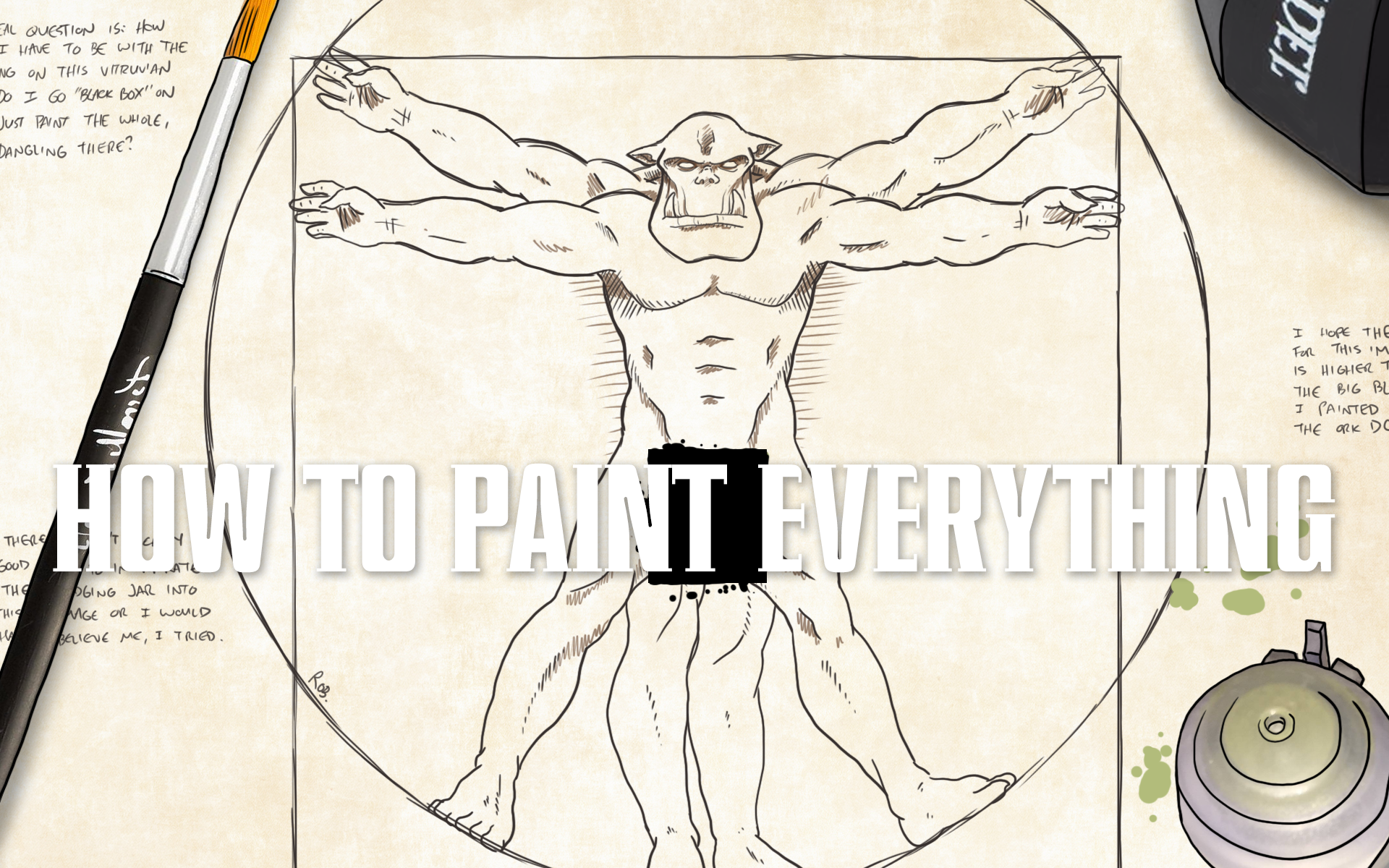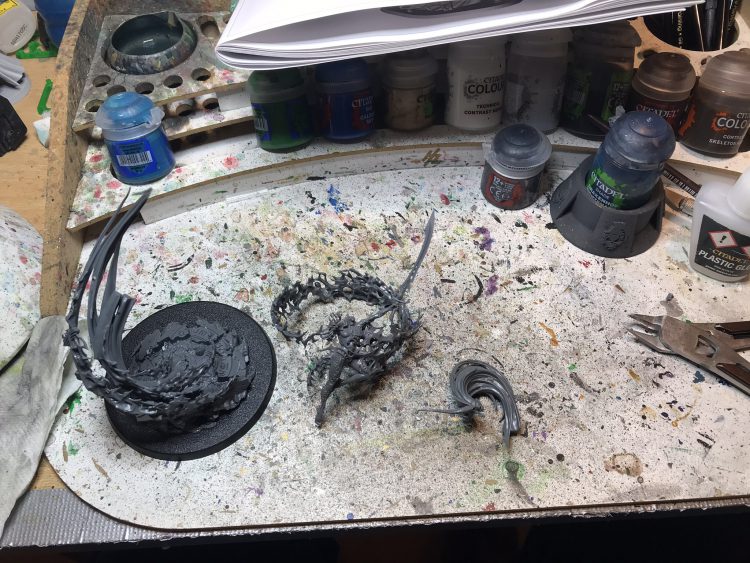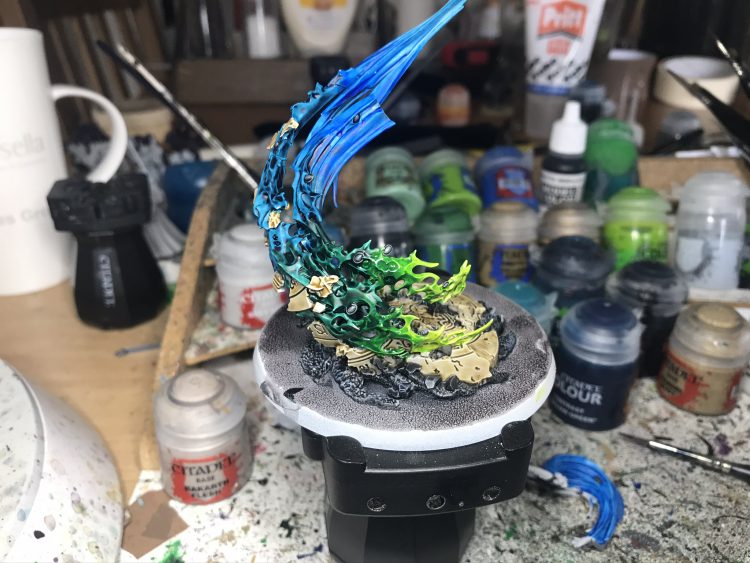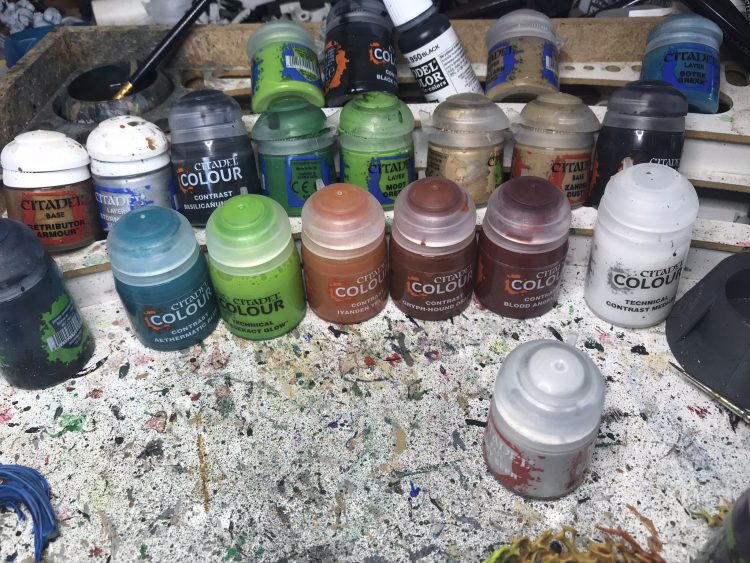In our How to Paint Everything series, we take a look at different armies of the Warhammer universe, examine their history and heraldry, and look at several different methods for painting them. A year ago we kicked off a three-part series on how to paint Ynnari, specifically the triumverate of Ynnead that make up the faction’s special named characters. After a long wait, we’re finally back with the Yncarne!
Prior Installments:
Part 3 – The Yncarne, Avatar of Ynnead
The Triumvirate of Ynnead consists of three characters, first introduced in 7th edition with The Gathering Storm II: The Fracture of Biel-Tan. Yvraine is one of two psykers in the Ynnead, and acts as the emissary of the Eldar God of the Dead. Originally born on the Biel-Tan Craftworld, Yvraine is a bit of an outlier among Craftworlders. Not only has she has walked many of the Paths of the Asuryani, acting as a Warlock, an Aspect Warrior, and a Corsair, but she also has a connection to wider Eldar culture in a way that few of her peers can match. After a mutiny among her Corsair crew forced her to flee to the Webway, she ended up in the Drukhari city of Comorragh, training in a Wych cult before ending up as a gladiator in the city’s arenas. As fate would have it, Yvraine met her end at the hands of a Priestess of Morai-Heg in the moments shortly after Eldrad’s ritual awoke the god Ynnead. The new awakened (and still weak) Eldar god of the dead recognized her as someone who had walked the light and dark paths of the Eldar and resurrected her to be his Emissary. Unfortunately this action also broke the seals on Khaine’s Gate, causing daemons to flood into Comorragh. Eluding capture by Vect thanks to the help of the Visarch, a mysterious but familiar ally wearing ancient armor, Yvraine and a group of Drukhari followers escaped into the Webway.
Yvraine and her followers spent some time wandering and gathering additional support from new converts to the path of Ynnead. She began to preach the Seventh Path, a process by which Ynnead could be fully awakened without the sacrificing the entire Eldar race. She traveled back to Biel-Tan and told the Craftworld’s seers this, and they did not respond well to the idea. Fortunately(?) for her, daemons of Slaanesh led by The Masque attacked the Craftworld, and the ritual Yvraine performed to save Biel-Tan fractured its infinity circuit, destroying it and releasing the souls needed to wake Ynnead.
Following the fracture of Biel-Tan, Yvraine led an expedition to recover the Crone Swords, powerful weapons vital to the Seventh Path. During this time, she crossed paths with Eldrad Ulthran, who had seen that the paths of the Eldar and the Imperium were joined. They decided to form a desperate alliance with the Imperium, helping the survivors from Cadia flee in the Webway to Ultramar. There, they healed Roboute Guilliman of the poison inflicted upon him by Fulgrim and revived him, helping him fight the forces of Chaos that had fallen upon the planet and forming an alliance. Since then, her quest to save the Eldar through the Seventh Path has continued.
Where to Read More
Like the rest of the Triumvirate of Ynnead, The Yncarne was first introduced in The Gathering Storm II campaign book, released at the tail end of seventh edition. Unlike the other two characters, the Yncarne isn’t really a character so much as a primeval force, the physical manifestation of the Eldar God of Death. As such, the Yncarne doesn’t get a lot of lines. It shows up in Gathering Storm Book II to fight off the Masque, then disappears after the Ynnari under Yvraine’s command are assaulted by the Thousand Sons.
- The Gathering Storm II Campaign Book introduces the Yncarne’s appearance and how it saves the fractured Biel-Tan Infinity Circuit.
- Psychic Awakening: Phoenix Rising features the return of the Yncarne in a battle with Shalaxi Helbane, a particularly nasty greater Daemon of Slaanesh.
Playing With the Yncarne
Good news! The Yncarne is worth fielding in games again. If you’re looking for some advice on playing with the Yncarne in 40k, check out our Faction Focus on Ynnari in 9th edition.
Painting The Yncarne
The Yncarne is easily one of the most complicated models in the 40k range, with lots of small details and recesses that can make it very challenging to paint.
Liam “Corrode” Royle’s Approach
I am far from the most disciplined or technique-focused painter on Goonhammer – my strength is industrial-scale painting, turning out multiple armies per year which look good enough on the table that people aren’t ashamed to play against them. That said, I enjoyed painting the Triumvirate of Ynnead a lot, and I think I did a pretty good job on them, so when HTPE: Ynnari came up I jumped to volunteer.
The Yncarne was the last model I painted from the Triumvirate. Yvraine was the most exciting and also the one that I thought would have the most immediate application and the Visarch was much smaller in scope. I had a vague plan to do the flames with the Hexwraith Flame paint which came out, but once Contrast was announced I knew that it was the perfect tool for this particular job.
In the end, I didn’t just do the flames with Contrast, but the hair and the bodysuit as well. After priming with Wraithbone, I contrasted the flames with Talassar Blue, the hair with Warp Lightning, and the bodysuit with Shyish Purple. This gave me a good base to work from, with the three main colours blocked in pretty quickly.
I then drybrushed all of the following:
Flames – Teclis Blue, then Lothern Blue, then Baharroth Blue (around where the flames come out of the body, I hit a bunch of edges to give it a glow)
Hair – Moot Green, then just at high points with Flash Gitz Yellow
Bodysuit – Xereus Purple, then Genestealer Purple
After that I washed them with Drakenhof Nightshade, Biel-tan Green, and Druchii Violet respectively, which sounds mental when you’ve already used Contrast but did work, trust me.
That was honestly 90% of the model. Gold was just the standard Retributor Gold -> Auric Armour, metals Leadbelcher -> Ironbreaker, and the skin built up through Kislev Flesh to Pallid Wych Flesh to keep the model nice and pale. Instead of doing a mix of different colour gems like on the Visarch, I did them all in red – I just repainted the Wraithbone brush-on primer onto the gems, hit them all with Blood Angels Red contrast, then layered Wild Rider on top before giving them a gloss varnish.
The only other big piece of the model is the Eldar ruins it’s emerging out of. I blocked these all in with Rakarth Flesh, then used Flayed One Flesh on “inner” bit with the runes cut into it. This all got washed Seraphim Sepia then relayered.
All in all, quite an easy job! A model which is much harder to build than to paint – the instructions are not good and there’s a ton of small attachments. Plastic glue is firmly recommended.
James “One_Wing” Grover’s Approach
So. The Yncarne eh. A while back I bought the Triumverate because I wanted Yvraine for quite a few of my 8th Edition lists, but I never quite got around to doing the Yncarne. They didn’t really fit into my normal style of list, and there always seemed to be something else nearer the front of the queue.
Part of that was definitely how intimidating the model looked to paint. I am not a fantastic painter – I have a resting hand tremor which makes precise work quite challenging, and while a lot of practice and learning techniques has got me up to a level I’m happy with, part of that is choosing my battles in which projects I go after. Large, smooth panels and face concealing helmets are very much my jam, and the Yncarne is uh, not that.
However, the time for hobby cowardice is over, for two key reasons. First up, Contrast is a thing now, and the Yncarne is, in theory, the perfect model to use it on. Certainly it made the idea of trying to paint the big energy swirls and the hair seem more approachable. Second, and if we’re honest the main reason, is that the Yncarne seems real good in 9th Edition, and the lists I’m happiest with of the ones I’ve written thus far use them.
All in all, that meant it was finally time, and you all get to join me on this journey.
Planning
First up, with something this complicated I felt like I needed a clear plan before I started. the main thing I was sure I didn’t want to do was the “official” scheme. It looks good, but I felt pulling off the very pale shades of blue and pink it uses effectively with Contrast was going to be hard to get looking great, and that something a bit deeper and more vibrant would work better. It would also fit more closely with the wider aesthetic of my army – bright, full colours (green on tanks and characters, the appropriate primary colours for the various aspects), whereas the pallid, sinister default would be a bit out of place.
My initial plan was to do something along the lines of:
- Talassar Blue on the hair.
- Akhelian Green on the body.
- Ork Flesh/Tesseract Glow on the energy swirl.
Green fits my existing forces, while the teal of the Akhelian would fit with how I’m planning to differentiate the other Ynnari units I’m painting. However, on playing this through in my head, it didn’t quite feel right. Mostly, without some sort of purple (as Liam has used) or red I was concerned, ironically, that there wouldn’t be enough contrast on the model. I also tested out some Akhelian green and found it coming out a bit darker than I wanted as the colour for what should be one of the key bits of the model.
I did like the idea of the blue-green transition though and wanted to keep some of that, and had a think about what I could do to keep it while fixing the issues.
In the end what I landed on was something a bit more ambitious. Blues and greens felt like they would work well on the flowing hair, and I liked the idea of using some sort of dark red on the body to sharply contrast with it. However, I didn’t want the energy swirl all in red, so would want to transition it to other colours along its length. Between that and wanting to transition the blue/green on the hair, I decided it was time to try one of those fancy new tricks I’ve been hearing about, which is Contrast blends.
The overall plan I ended up on was as follows:
- Bright blue transitioning through to bright green on the hair swirl.
- Pallid pink for the face (a small nod to the official scheme).
- Dark red on the body.
- A rainbow transition from red through to bright green-blue on the energy swirl.
- Beige for the chunks of Aeldari temple.
- Grey for the rubble/dirt.
- Metal detailing.
Ambitious – let’s see how it went.
Preparation
I’ve been trying to paint my models in larger parts recently as it makes a number of things a lot easier, but here it was clear that I’d need to keep some parts separate. Since I was going to use quite a different set of colours on the “supporting” swirl coming out of the ground and the one spiraling out from the body, and the head was the split point (and also load bearing), I went with three subassemblies:
- The base and supporting swirl.
- The head and the first chunk of hair.
- The body and the energy swirl.
I put all this together and used some masking tape to cover off the places they would later join together. I don’t always bother with this, and try to awkwardly get plastic glue to work even after painting, but here I thought the joins were likely going to be finicky enough that I’d want the glue to work easily. I should note that this turned out to be extremely true – the final assembly of this model is a total pain – so definitely make sure you keep the joins clean if you’re sub assembling. Once the tape was on, I primed with Grey Seer, and was ready to go.
Painting
First up, I had to be disciplined and do the really boring bit. This comprised:
- Blocking in black templar on anything that was going to end up metallic, something I always do when working on top of one of the contrast primers.
- Painting the rubble and ruins on the base. For this I used a few coats of thinned Skeleton Horde on the ruin bits, and Basilicanum Grey followed by thinned Black Templar on the rubble.
With that out the way, I could go on to doing the first of the two exciting bits, and decided to do the swirly coming up from the base first (along with the hair on the separate head piece). The plan, as covered above, was to do a gradual contrast transition, and the mechanism for doing this was basically:
- Paint a section in one Contrast colour.
- While still wet, paint about the first centimeter of the next colour in, starting right up against where the first colour was.
- Charge my brush with Contrast medium and work it around the point where the colours overlap, blending them together and giving a nice transition.
For this first section, I used the following series of colours (in order):
- Aethermatic Blue at the very tip.
- Talassar Blue
- Akhelian Green
- 50:50 Akhelian Green/Ork Flesh
- Ork Flesh
- Tesseract Glow (which I am designating an honorary Contrast paint for these purposes).
The terrifying part about this, obviously, is that once you start you ideally need to keep going, and a frenzied half-an-hour later and I had this:
That, honestly had worked shockingly well. I had to do a bit of tidying, and then used drybrushing to finish off the colour at various points. I can’t recall if the above picture was pre- or post-drybrush, but basically all I did on top of the contrast was light brushes of:
- Imrik Blue and Gauss Blaster Green for the Talassar
- Sotek Green and Gauss Blaster Green for the Akhelian/Akhelian mix
- Moot Green for the Ork Flesh
- Flash Gitz Yellow for the Tesseract.
Once that was gone, I finished off the spiritstones for this section. I painted the whole of all of them with Retributor Armour, nuln oiled them, applied Stormhost Silver to them gems themselves then completed with thinned Blood Angels Red or Gryph Hound Orange.
OK, so far so good. Now for the body and swirl. For the body itself I used a thinned mix of 50:50 Blood Angels Red and Shyish Purple. I am extremely wary of Shyish – it gets good coverage, but I’ve found it one of the worst Contrasts for pooling and ending up blotchy, hence the mix. I also lined up my armaments so I was ready to go straight into the swirl transition.
From the Blood Angels/Shyish mix, the plan was:
- Blood Angels Red
- Gryph Hound Orange
- Iyanden Yellow
- Tesseract Glow
- Aethermatic Blue
Once more I went for it in a flurry of activity, and once more the outcome was pretty good.
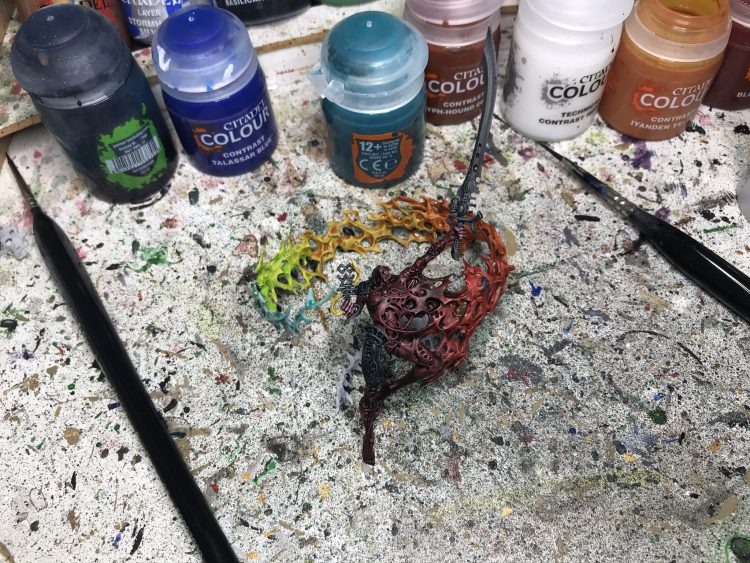 I again followed up with some drybrushing, paying particular attention to the body, which had come out a bit drab. Some Evil Sunz Scarlet and Fire Dragon Bright brought that up nicely. I used Fire Dragon Bright and Flash Gitz Yellow on the rest, and then did the gems as before, except using blues and greens rather than red and orange where that was needed to contrast with the swirl.
I again followed up with some drybrushing, paying particular attention to the body, which had come out a bit drab. Some Evil Sunz Scarlet and Fire Dragon Bright brought that up nicely. I used Fire Dragon Bright and Flash Gitz Yellow on the rest, and then did the gems as before, except using blues and greens rather than red and orange where that was needed to contrast with the swirl.
Finally on this section, I needed to do all the metals on the body. For this I used:
- Grey Knights Steel washed with Drakenhoff for the large plates on the thigh and shoulder.
- Retributor Armour washed with Druchii Violet for the filigree and raised sections of the plates.
- Runelord brass washed with Agrax on the sword handle (plus some Basilicanum Grey on the grooved bit to darken it).
- Leadbelcher highlighted with Stormhost, washed with thinned Basilicanum on the sword.
I also added colour to the gems as usual.
Finally, the head. The hair was Talassar, continued from the base mount, and for the face itself I washed the Grey Seer very gently with Druchii Violet for a pallid effect, then highlighted with Grey Seer to which I’d added a tiny amount of the violet. I dotted the eyes with Stormhost then added Tesseract Glow, and for the horn I painted it in Grey Knight Steel, washed with Drakenhoff and drybrushed Stormhost. The face armour is just Retributor > Druchii > drybrush Gehenna Gold.
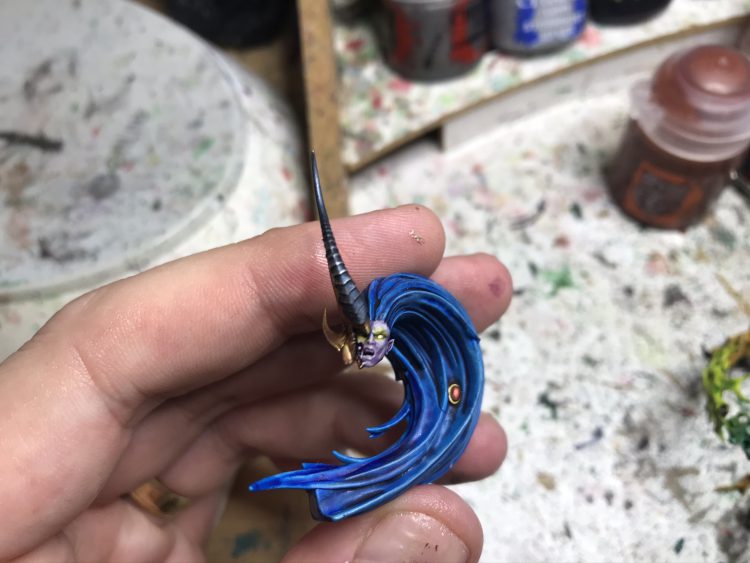 Nearly there now – at this point I assembled the model and then added Astrogranite Debris to the non-scenic bits of the base.
Nearly there now – at this point I assembled the model and then added Astrogranite Debris to the non-scenic bits of the base.
Getting this together was a complete pain and I abraded the paints off the tips of some bits of the swirl, but luckily this was very easy to tidy up with thinned contrast of the appropriate colour. Once the Astrogranite had dried, I washed it with Basilicanum Grey and drybrushed with Dawnstone. Finally, I painted the base rim black and we were done!
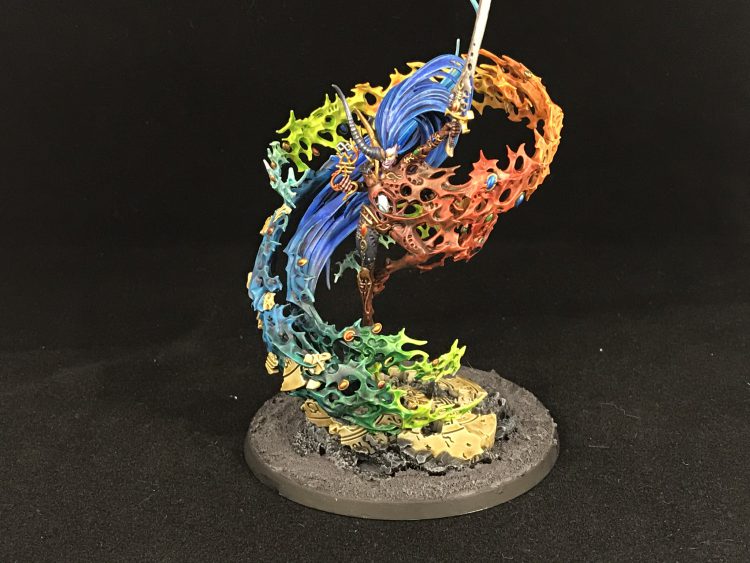 I’m thrilled by how this came out and surprised by how easy it was – I’ll definitely be looking for opportunities to use Contrast blends in the future, as the results with minimal practice or skill were much, much better than I expected. I’d also strongly recommend the Contrast option for anyone else intimidated by this model, and I now look forward to actually getting it out on the table!
I’m thrilled by how this came out and surprised by how easy it was – I’ll definitely be looking for opportunities to use Contrast blends in the future, as the results with minimal practice or skill were much, much better than I expected. I’d also strongly recommend the Contrast option for anyone else intimidated by this model, and I now look forward to actually getting it out on the table!
The Triumverate is Complete
That wraps up our look at how to paint the Triumverate of Ynnead! Thanks again for bearing with us, especially you poor souls that waited all this time for part 3. As always, if you have any questions or feedback, drop us a note in the comments below or email us at contact@goonhammer.com.
